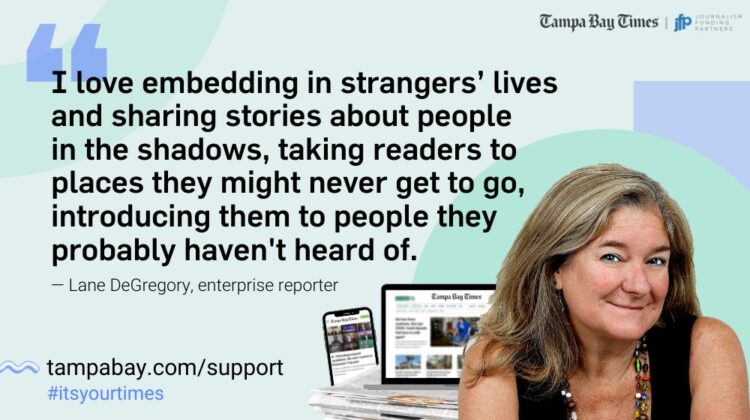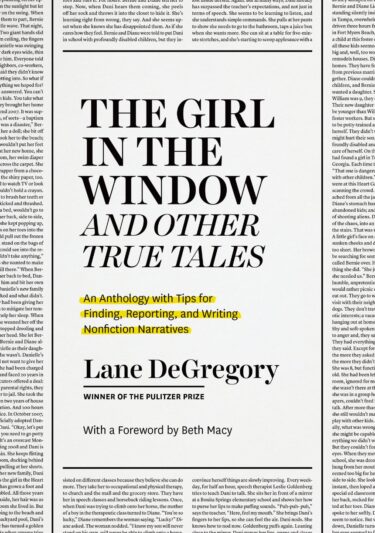After reading a remarkable work of nonfiction, have you ever wished you could learn exactly how the writer created what you just read? I don’t think I’m alone in being intrigued by how the stories that move me came about. We all juggle required assignments with passion projects. We all decide to ask our sources certain questions and not to ask others. We all need to arrange the information we find into a particular experience for our readers. But some articles rise above the ordinary to create memorable experiences for readers.
How does that happen?
Lane DeGregory, the Pulitzer-Prize winning enterprise reporter for The Tampa Bay Times, has created more than her share of these extraordinary experiences for readers. In her new book published this month, “'The Girl in the Window 'and Other True Tales,” DeGregory shows that not only does she have the knack for writing emotionally detailed narrative articles, she also has an incredible memory for how those articles came to be and an admirable generosity in sharing her techniques.
Here, I must confess to being a Lane DeGregory fan. I’ve listened to every episode of WriteLane, a podcast of story craft conversations between DeGregory and her former editor, Maria Carillo. In a two-minute video interview, she discusses her passion for storytelling. And I got to speak with DeGregory two years ago for a Storyboard piece about the reporting and writing decisions that went into her 2002 profile of a transgender woman.
DeGregory’s new book collects 24 of the stories that have appeared under her byline over the years. The anthology inevitably includes some old favorites, along wiht bits of advice that DeGregory has mentioned in her podcast or at conferences and workshops. Still, encountering them in a new form is a helpful reminder of her creative and compassionate approach to profiles, including:
- to ignore the “important” people for the more interesting people in the shadows
- to suggest that a story subject bring a friend or relative to an interview help them feel safer
- to find the “bruise on the apple” by including a profile subject’s flaws so that they come across as fully rounded and credible humans
- to always get documents, official and personal, not just to fact-check what your subject is telling you but because they often include specifics helpful for creating a narrative
The book also offers insights into DeGregory's work that I hadn't heard before, including the various ways she has written about subjects being dishonest with her or with others, while still portraying these people empathetically. For example, in a story about panhandlers, DeGregory mentions a man who “swears he fought in ’Nam,” wears a hat that says “U.S. Air Force” and carries a sign with the Marine motto, “Semper fi.” In an annotation about it in her book, Gregory writes:
Some of the best characters are flawed and unreliable. I needed the panhandlers to trust me…. But I wanted readers to know that I didn’t believe everything they were saying…. You don’t have to aggressively challenge their claims. But alluding to conflicting military allegiances, you can hint that the truth is elusive.
I know that when writing narrative, especially the intimate narratives DeGregory specializes in, there will always be people who won’t talk with you and mysteries that will remain unsolved no matter how long you dig. For example, a story about a child's murder includes a section where many people in the child's life express their guilt and regret over small actions that may or may not have saved the child. She writes about asking the same question of people closest to the child but who declined to talk to her. Rhetorical questions about their roles, along with the simple sentence, “None of them would say what happened,” tells the story these sources would not.
Lessons for beginners and pros
The book is published by the University of Chicago Press, so easy to see as a textbook for journalism classes — and to envy the students in those classes; anyone who aspires to narrative journalism would be fortunate to be exposed early on to DeGregory’s empathetic stories and the exacting details of her approach. But journalists of all levels and experience should find valuable tips.
For each story in the anthology, DeGregory lists how long it took to report and how long to write. She describes how and why it was assigned, and sometimes her reaction to getting that assignment. She doesn’t always welcome each assignment — which in itself is a good lesson for beginning journalists, and a good reminder for experienced pros. But it’s what she does with those less welcomed assignments that’s worth the price of the book.
DeGregory may have resisted writing an anniversary story of a heinous crime, rejected following the journalistic pack to Orlando to report on the Pulse nightclub shooting and snubbed a public relations person’s plea to write about foster children. But how she made each of those stories her own offers the rest of us possibilities for our own unwelcome assignments.
For the crime anniversary, DeGregory dug a little deeper than the many who had already covered the story, revealing the humanity of both a murderer and his victim. For the nightclub shooting, she avoided the journalistic pack and found a unique perspective on a heavily reported event. And by focusing on a single foster child — one with an extraordinarily painful story finally turning toward hope — DeGregory wrote the series that won the 2009 Pulitzer Prize for feature writing.
The table of contents is organized by the core journalistic strategy demonstrated in the featured story, allowing readers to dip into wisdom they find most useful or intriguing. Running in the margins of every story are insights into DeGregory’s reporting and writing process. She reveals the question she asked to get that great quote. She points out wordplay and her thought process while writing those words. Even better, she admits when hunches or pure luck resulted in journalism gold. The result is a little like a Storyboard annotation and a little like having DeGregory herself reading over your shoulder and explaining the techniques behind the magic.
“The Girl in the Window and Other True Tales” satisfied my curiosity about how these richly textured stories were created and offered advice and inspiration to dive into my next narrative journalism project.
* * *
Madeline Bodin is a freelance environmental and science journalist based in Vermont.




